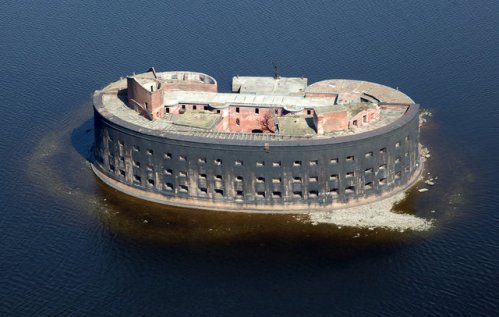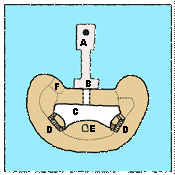

Location: Leningrad Oblast Map
Fort Alexander I or more commonly known as a Plague Fort is located in the Finish Gulf of the Baltic Sea just few miles from Saint Petersburg (capital of the Russian Empire at the time). Fort Alexander I or Plague Fort was constructed in 1838- 45 under supervision of Russian- French engineer Moris Gugovich Destrem (Jean Antoine Maurice) and Mikhail von der Veide as a military bastion to defend former capital of the Russian Empire against enemy fleets. It was part of the forts that included other citadels like "Peter I", "Fort Risbank aka Pavel I", "Fort Constantin" and "Kronshlot". It measured 60 meters by 90 meters with 4 levels high. It was supported by 5535 piles that reached a height of 12 meters. A layer of sand, concrete and granite slabs further strengthened the base for the military fortifications. It was officially commissioned on 27th July 1845 by Nikolay I (Nicholas I) and named in honor of his father Alexander I. Its defenses consisted of 137 cannon and a garrison of over 1000 soldiers. During Crimean War the British Royal Navy fleet approached Kronstadt and Saint Petersburg, however a line of impressive forts and first naval mines stopped any attempts to attack Russian capital and Russian fleet. In 1869 the fortress ceased its use as a military fortification.
Today fort Alexander I undergoes a massive reconstruction. There are plans to turn the old citadel into a tourist destination, including museum, bar, restaurant and a club. It is accessible for tourists by boats.
Since the founding of St. Petersburg in 1703, the waterways in
the Gulf of Finland have been of strategic importance to Russia.
Peter I started building forts in the Gulf of Finland and the
first military facility on the island of Kotlin - Fort Kronshlot
in 1704. Over the next two centuries, the fortification of this
area was continued.
Louis Barthelemy Carbonnier (aka Lev
Lvovich Carbonnier) in the 1820s developed a project for two sea
forts to strengthen the defense of the southern fairway. The
shape of the forts should have been the upper part of a
horizontally lying torus, due to which at any point the fortress
wall would have a surface of double curvature, which should have
led to the ricochet of round cannonballs. In the walls
overlooking the inner side of the fort, it was supposed to
arrange loopholes to combat the possible penetration of enemy
landing forces. In the basement of the wall, it was supposed to
arrange premises for the placement of missile launchers.
However, this original project was not implemented, although the
walls at the very edge of the water at the implemented structure
received a concave shape, which largely protected them from the
breaking wave. In the future, all newly constructed forts were
designed taking into account the placement of rocket launchers.
After the death of Carbonnier, in 1836, a special committee
headed by Lieutenant-General Jean-Antoine-Maurice Destrom of the
Corps of Railways, revised the plan for a new fortress.
Construction began in 1838 after the approval of a new project
by Emperor Nicholas I under the leadership of engineer-colonel
Michael von der Weide. Under the foundation of the entire fort,
in order to strengthen the ground, 5335 12-meter piles were
driven, the space between which was filled with concrete based
on hydraulic lime. On concrete, laying of granite blocks began.
In the summer of 1842, the laying of walls from specially
selected bricks began. Then the fort was covered with granite
around the entire perimeter. The solemn transfer of the fort
from the construction department took place on July 27, 1845,
the fort was named after the brother of Nicholas I - Emperor
Alexander I.

A. Pier
B. Main Entrance
C. Inner courtyard
D. Doors
F Crematorium
E. Elevator
It was a typical casemated sea fort of that time. It is similar to the
famous Fort Bayard off the West coast of France, the construction of
which was completed later than "Alexander I".
The fort was an
oval building 90 by 60 meters, with three floors and a courtyard in the
center. On the Kronstadt side, builders erected a pier and an office
building for services and personnel. Like all defensive structures of
that time, the fort "Alexander I" was picturesquely decorated: in the
courtyard there was a half-tower with spiral cast-iron stairs, gates
decorated with lion heads, anchors and flags. There were also rooms for
nuclear furnaces. The total area is over 5000 square meters. There was
enough space in the fortress to keep a garrison of up to 1000 people.
The fort was armed with 103 guns, which included the latest three-pound
bomb cannons, which were the most powerful fortress guns at that time.
The purpose of the creation of the fort was to control the Southern
Fairway with a crossfire system together with the forts "Peter I",
"Risbank" ("Paul I") and "Kronshlot". The fort never saw combat,
however, it did play a role in the Crimean War when it protected the
naval base at Kronstadt from attempts by the Royal Navy and the French
Navy to advance towards the Russian capital. In 1854, during an
unsuccessful attempt to capture the fortress of Kronstadt, several
British steamships were damaged by an underwater explosion of Russian
naval mines designed by Jacobi.
Fort "Alexander I" was in full
combat readiness three times: in the summer of 1855, when the
Anglo-French fleet tried to carry out minesweeper raids using small
steamers; in 1863, when there was a possibility of a confrontation with
the British Empire; during the Russian-Turkish war of 1877-1878.
In 1896 he was excluded from the defensive structures.
Doctors at the bed side of their sick colleague. He survived.
Director of the Institute of Experimental Medicine
(IIEM), professor of forensic medicine Sergei Mikhailovich Lukyanov in
1899 opened the first anti-plague laboratory in Russia in the former
fort "Emperor Alexander I" of the Kronstadt fortress.
The
secluded fort turned out to be the most suitable location for the
Special Laboratory (station) for the production of vaccines and immune
serum using horses as working material. The fort was reconstructed in
1897-1899, mainly at the expense of Prince Alexander Petrovich of
Oldenburg. The fort was equipped with steam heating for the stables, an
elevator for raising animals and an oven for their cremation. On July
27, 1899, the solemn consecration of the station took place. After that,
several doctors settled in the fort. To communicate with the outside
world, the scientists of the fort were allocated a small steamer called
"Microbe".
With the outbreak of the First World War, scientific
research in the "Special Laboratory ..." almost stopped, and most
scientists were drafted into the army. The February Revolution of 1917
led to the resignation of A.P. Oldenburgsky from the post of trustee of
the IIEM (March 9). At the end of 1917, cultures of plague and cholera
pathogens were taken to Saratov, where in the fall of 1918 the country's
first anti-plague institute "Microbe" was established.
Since 1923, the fortification again passed into the
hands of the military, who created a warehouse for mine-sweeping
equipment there. By 1983 the fortress was abandoned. Around the same
time, during the filming of the film "Gunpowder", as a result of the
fire necessary for the plot, the fort burned out.
In the 1990s,
the authorities of Kronstadt repeatedly rented out its territory for
rave discos.
In 2004-2005, the television series Favorsky and Sea
Devils were filmed on the territory of the fort.
In 2007, the
construction of the St. Petersburg Flood Protection Complex affected the
fort while deepening the bottom of the navigable Sea Canal. After
analyzing the situation, the construction boundaries were pushed back by
300 meters. Despite this, KGIOP stated that after the expansion of the
fairway in the area of the fort, the wave load will increase. In
addition to waves, ebbs and flows, there will also be a load from the
movement of ships.
Now there is a construction project in the
fort of an entertainment complex with a theater stage, a museum, a cafe,
a bar, a restaurant, a shopping area. The cost of reconstructing the
fort is estimated at about $43 million.
Since 2011, boat trips to
the fortress have been available.
In 2020, closed to the public,
used as a base for the Russian military.
In 2020, a project was
developed for the restoration of the fort with the arrangement of a
hotel and a museum of the history of microbiology in it. At the
beginning of 2021, restoration and reconstruction work began, with the
involvement of the Ministry of Defense, as part of the Island of Forts
project.